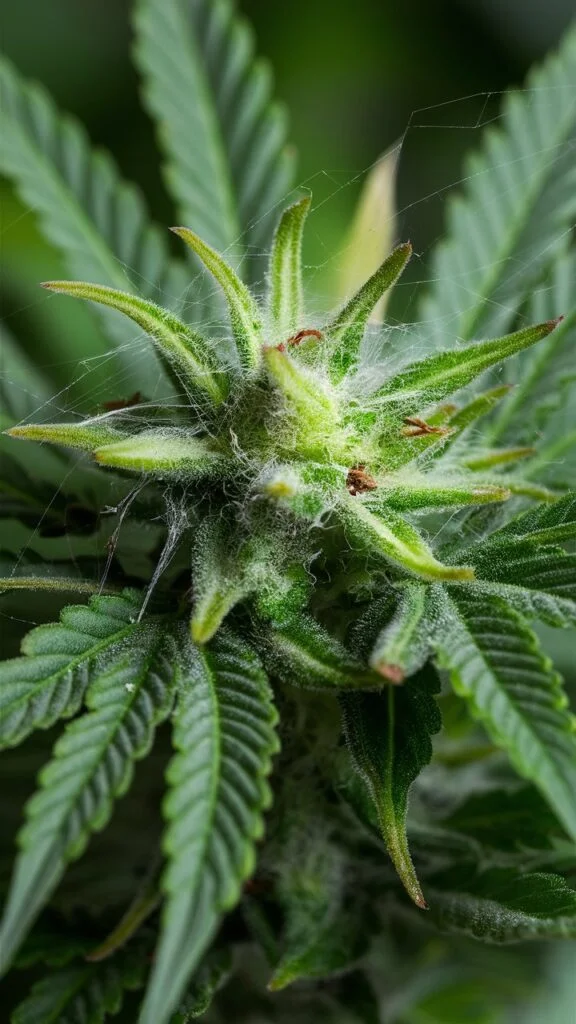Learn how to detect, prevent, and treat spider mites on cannabis plants. Discover effective strategies to protect your crops from these damaging pests and ensure healthy growth.
Spider mites are tiny but formidable pests that can wreak havoc on cannabis plants. These microscopic arachnids can quickly infest a crop, causing significant damage and potentially ruining your harvest. In this guide, we’ll explore how to identify spider mites, prevent infestations, and effectively treat your cannabis plants if they become affected.
Here is a chart with detailed information on Cannabis plants:
| Category | Information |
|---|---|
| Botanical Name | Cannabis sativa, Cannabis indica, Cannabis ruderalis |
| Common Name | Cannabis, Marijuana, Hemp |
| Plant Type | Annual Herb |
| Hardiness Zone | Typically grown as an Annual in All Zones |
| Sun Exposure | Full Sun |
| Soil Type | Well-drained, Loamy, Fertile Soil |
| Watering | Moderate, Keep Soil Consistently Moist |
| Growth Habit | Upright, Bushy |
| Height/Spread | 3-18 feet tall / 3-6 feet wide (Varies by Strain) |
| Flowering Time | Late Summer to Fall (Indoors: Controlled by Light Cycles) |
| Flower Description | Dense Clusters of Small Flowers (Buds), Usually Covered in Trichomes |
| Special Features | Produces Psychoactive Compounds (THC), Used for Medicinal and Industrial Purposes, Requires Controlled Growing Conditions, Sensitive to Light Cycles |
Understanding Spider Mites

Before we dive into detection and treatment, let’s understand what we’re dealing with:
- Spider mites are arachnids, related to spiders and ticks
- They’re extremely small, typically less than 1mm in size
- They reproduce rapidly, with a life cycle of about 1-2 weeks
- They thrive in warm, dry conditions
How to Detect Spider Mites on Cannabis
Early detection is crucial for effective treatment. Here’s what to look for:
Visual Signs:
- Tiny spots or stippling on leaves
- Yellowing or bronzing of leaves
- Fine webbing on leaves and between branches
- Leaves becoming dry and falling off
Inspection Techniques:
- Use a magnifying glass to examine the undersides of leaves
- Shake a leaf over a white piece of paper – moving dots indicate mites
- Look for tiny, moving specks on the plant, especially in warm areas
Preventing Spider Mite Infestations
Prevention is always better than cure. Here are some strategies to keep spider mites at bay:
- Maintain cleanliness: Keep your grow area clean and free from debris
- Control temperature and humidity: Spider mites prefer warm, dry conditions. Keep temperatures below 80°F (27°C) and humidity above 60%
- Quarantine new plants: Isolate new additions for at least a week before introducing them to your grow area
- Use preventive sprays: Regularly mist plants with water or a neem oil solution
- Introduce beneficial insects: Predatory mites can help control spider mite populations
Treating Spider Mite Infestations
If you’ve detected spider mites on your cannabis plants, don’t panic. Here are some treatment options:
Organic Methods:
- Neem oil: Mix with water and spray on plants, focusing on undersides of leaves
- Insecticidal soaps: These can be effective against mites without harming plants
- Diatomaceous earth: Sprinkle on soil and leaves to dehydrate mites
- Predatory mites: Introduce natural predators like Phytoseiulus persimilis
Chemical Methods:
- Pyrethrin-based insecticides: Effective but use cautiously as they can affect beneficial insects
- Abamectin: A potent miticide, but should be used as a last resort
- Spiromesifen: Another strong option for severe infestations
Important Treatment Tips:
- Always follow product instructions carefully
- Treat the entire plant, including undersides of leaves
- Repeat treatments according to the product’s recommended schedule
- Continue monitoring plants closely after treatment
Post-Treatment Care
After treating your plants, it’s crucial to:
- Monitor plants closely for signs of re-infestation
- Improve growing conditions to prevent future outbreaks
- Consider adjusting your preventive measures
The Impact of Spider Mites on Cannabis Quality
Spider mite infestations can significantly affect the quality and yield of your cannabis crop:
- Reduced photosynthesis due to damaged leaves
- Stunted growth and reduced bud development
- Potential contamination of buds with mites and their eggs
- Increased susceptibility to other pests and diseases
When to Seek Professional Help
While many spider mite infestations can be managed at home, sometimes professional intervention is necessary. Consider seeking expert help if:
- The infestation is severe and spreading rapidly
- Multiple treatment attempts have failed
- You’re unsure about using chemical treatments safely
- You’re growing cannabis commercially and need to protect your investment
Spider mites can be a significant threat to cannabis plants, but with vigilance and proper care, you can prevent and manage infestations effectively. Regular inspection, maintaining optimal growing conditions, and quick action at the first sign of mites are key to protecting your plants.
Remember, the health of your cannabis plants directly affects the quality of your final product. By staying informed and proactive about pest management, you’re ensuring the best possible outcome for your crop.
Learn more about integrated pest management for cannabis
Discover other common cannabis pests and how to manage them
Stay vigilant, and happy growing!
For more gardening tips and
Pingback: Male vs Female Cannabis Plants : Essential Differences for Growers